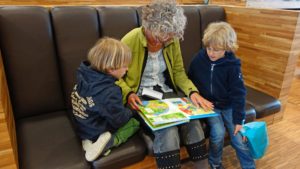Strategies And Tips To Support Shared Book Reading
 The importance of reading with your child is well known! Books expose children to ideas, words and experiences they would not typically get to see in their everyday lives! Book reading is great for the development of language skills, vocabulary, early print awareness (e.g. letters, words and sentences) and phonological awareness (e.g. rhyming).
The importance of reading with your child is well known! Books expose children to ideas, words and experiences they would not typically get to see in their everyday lives! Book reading is great for the development of language skills, vocabulary, early print awareness (e.g. letters, words and sentences) and phonological awareness (e.g. rhyming).
Book sharing with children is not just about reading the words of the story! You don’t just have to read the words to get all the benefits out of books!
So how do we get the most out of our book reading experiences with our children?
Here are 5 key strategies or ideas you may like to incorporate into your book sharing with your child to support their understanding, learning and enjoyment of books.
1. Activate background knowledge
Activating background knowledge is all about accessing a child’s existing knowledge of the book’s topic before you begin reading. This can help children to understand what they are reading by making links between their existing knowledge and new ideas in the story.
Let’s think about ‘The Very Hungry Caterpillar’ book. Before you begin reading this story, you might ask your child what they know already about caterpillars. You can talk about where they live, what they eat, what they look like and even relate back to your own experiences. Maybe you have seen a caterpillar in your garden eating leaves!
2. Asking questions
 Asking questions throughout the story can support your child’s understanding of what’s happening and also allow you to check in with your child to see how much they are understanding. Depending on the age of your child the types of questions you ask will vary.
Asking questions throughout the story can support your child’s understanding of what’s happening and also allow you to check in with your child to see how much they are understanding. Depending on the age of your child the types of questions you ask will vary.
For younger children, questions that begin with who, what and where or search and find questions based on colours, things or sizes are great! In our ‘Very Hungry Caterpillar’ book we may ask; ‘Where is the caterpillar?’ ‘What is he doing?’ ‘Find something on the page that is green!’
As children get older we can ask trickier questions that begin with ‘why’ and ‘how’. These types of questions can support predicting (what do you think will happen next?) and inferencing skills (i.e. reading beyond the text).
If your child is unable to answer your question, you can provide scaffolding and choices to help them reach the answer. For example; ‘Is the caterpillar ON the leaf or UNDER the leaf’ or ‘He has eaten SO much food. How do you feel when you eat too much food?’
Be sure to keep a good balance between questions and comments throughout the story.
3. Teach unfamiliar words to build vocabulary
Vocabulary plays a very important role in our understanding of language and comprehension of reading. Books expose children to a wide variety of words that they would not typically hear during everyday play and conversation. To support a child’s vocabulary growth we can pause on unfamiliar words and provide a child friendly explanation.
To support learning of the new word you could:
- Get your child to say the word
- Discuss words that are similar and opposite
- Show them how to use it in a sentence
Try to use that word throughout the week in different situations
4. Summarise or retell the story
 Asking the child to tell you what the story was about or providing a summary for them can support understanding of story structure – i.e. beginning, middle and end.
Asking the child to tell you what the story was about or providing a summary for them can support understanding of story structure – i.e. beginning, middle and end.
Key narrative elements include:
- Beginning; who (characters), what, where (setting) and when the story takes place
- Middle; the problem of the story, feelings and actions the characters take to solve the problem
- End; where the problem does/doesn’t get fixed and usually more thoughts and feelings by characters
The above elements are key to include in your summary or to support your child to include in their own retell!
5. Make it fun!
Last but definitely not least is to make book sharing fun! Children learn best when they are engaged and having fun. Some ideas you might like to try to keep stories exciting are;
- Using voices for characters
- Making sound effects – think animal noises and words like ‘crash’ ‘bang’
- Act out the story during – use facial expressions, gestures and actions to make the story come alive
If you are concerned about your child’s language skills, or would like to know more about language development, you can get in contact with one of our Speech Pathologists or our client care team via email on [email protected], phone (07) 3265 4495, or via our website.

Kimberly Killick
Speech Pathologist
